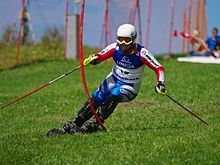Grass ski
Grass skiing is a sport that is practiced on grassy slopes from spring to autumn . The movement sequence is closely related to alpine skiing . The sports equipment used, the grass ski , differs entirely from the ski used for winter sports . The runner rolls over the slopes with grass skis , gliding like on snow has not been possible until now. That is why grass skiing is also known as roller skiing alpine .

history
As early as 1883, a “roller ski boot” was registered for a patent in Austria, but it was quickly forgotten. The forerunner of the grass skis used today was developed in 1960 by the German Josef Kaiser to give alpine skiers a training opportunity during the snow-free time away from the glacier ski areas. As summer training, however, grass skiing never prevailed and so athletes began to specialize in grass skiing. In the 1960s and 1970s, the new sport spread from Germany, first via Austria, Switzerland and Italy, then to Western Europe, Asia and Australia. Grasski later also became popular in Eastern European countries, Turkey and Iran.
As the number of active grass skiers increased, national and international competitions and racing series began to develop. In 1971 one was first Grasski European Cup held in 1976 was the first European Championship organized since 1979 and every two years world championships instead. In 2000 the European Cup was replaced by the Grass Ski World Cup .
Grass skiing is generally not counted as a roller sport (offshoot of roller skating, including adapted winter sports), mainly because the urban component of practicing on asphalt is missing. This is why the sport is still organized by the ski associations, with which it shares the infrastructure of the lifts and slopes.
Grasski received his own lecture in 1976 in the German Ski Association and in 1978 in the Austrian Ski Association . In 1985 Grasski was integrated into the International Ski Federation (FIS) under President Marc Hodler . The decision was made at the XXXV. FIS Congress in Vancouver . Before that, grass skiing was organized and regulated by the International Grass Ski Association (IGSV). The first chairman of the FIS Grasski Committee was the Austrian Robert Apschner, who was previously President of the IGSV. He was followed in 2002 by the Czech Jiří Russwurm.
equipment
Grass ski and binding
A grass ski consists of a running rail, over which the so-called surface - a belt with sliding elements - runs with the help of rolling elements, and thus resembles the chain running gear of a tracked vehicle . The belt is protected from dirt with a special plastic film. The running rail is connected to the binding via a wooden plate , on which a fixed connection to a conventional ski boot is established via two metal brackets with a buckle .
The maximum height of a grass ski is 12 cm. The length is limited to 80 or 85 cm for children up to 14 years of age; for juniors from 15 years and adults the maximum length is not limited, it goes up to about 100 cm. The distance between the upper and lower running rails, measured at the ends of the binding plate, must not exceed 66 mm.
More equipment
In FIS competitions and the associated training runs, the use of ski helmets and back protectors , such as those used in alpine skiing, is mandatory. The other items of equipment such as racing suits, ski boots, ski poles and gloves also correspond to those used by alpine skiers. Ski goggles are not worn by all runners.
Disciplines
In grass skiing, the disciplines of slalom , giant slalom , super-G , super-combination (formerly combination ) and, more rarely, parallel competitions are held. In contrast to the alpine races, women and men usually drive one after the other on the same course.
Competitions
The competitions in grass skiing are organized by the FIS. In addition to FIS races , the World Cup has been held annually since 2000 and a world championship every two years since 1979 . A junior world championship has been held annually since 1990 for young grass skiers between the ages of 15 and 20 .
Before the introduction of the World Cup, a Grass Ski European Cup had been held since 1971 and a European Championship from 1976 to 1996, alternating with the World Championships . From 1975 to 1989 Junior European Championships were held.
supporting documents
- ↑ a b c Austrian Ski Association (Ed.): 100 Years of the Austrian Ski Association . Ablinger & Garber, Hall in Tirol 2005, p. 211 f .
- ↑ a b History and disciplines in grass skiing. (No longer available online.) Www.oesv.at, archived from the original on February 12, 2010 ; Retrieved October 11, 2009 . Info: The archive link was inserted automatically and has not yet been checked. Please check the original and archive link according to the instructions and then remove this notice.
- ^ History of grass skiing. ( Memento of October 29, 2008 in the Internet Archive ). www.grasski-deutschland.de
- ↑ a b c International Grass Ski Competition Rules (2008 edition). (PDF) (No longer available online.) International Ski Association, p. 45 , archived from the original on April 1, 2010 ; Retrieved October 11, 2009 . Info: The archive link was inserted automatically and has not yet been checked. Please check the original and archive link according to the instructions and then remove this notice.
Web links
- www.grasski.at - Grasski in Austria
- www.swissgrasski.ch - Grasski in Switzerland
- www.grasski.de - Grasski website

